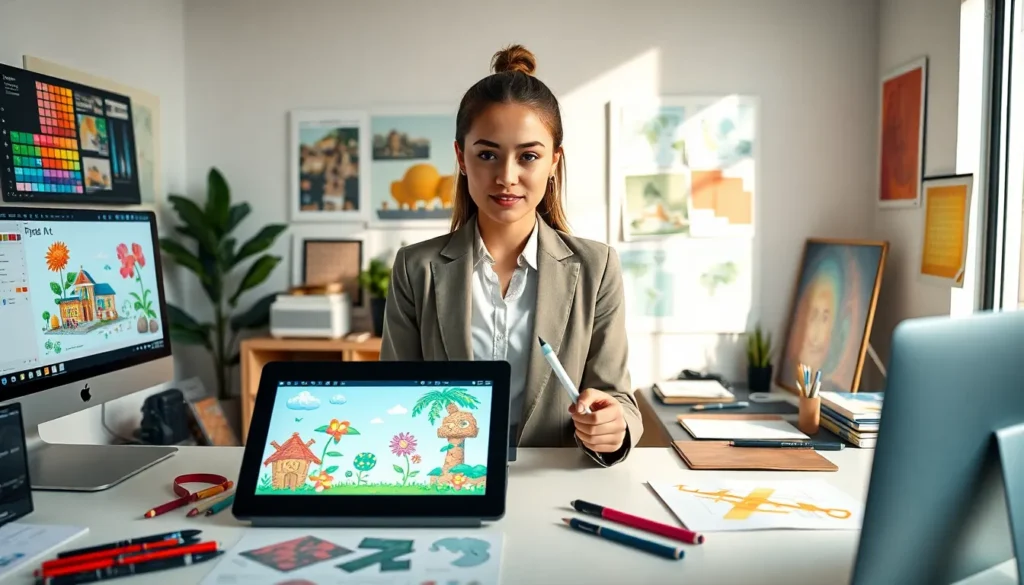Table of Contents
TogglePrintmaking has dramatically shaped the world of illustration, transforming how artists communicate their visions. I’ve always been fascinated by how this medium opened doors for creativity and expression, allowing illustrators to reach wider audiences than ever before. The ability to reproduce images not only made art more accessible but also sparked new styles and techniques that continue to influence illustrators today.
As I delve into the impact of printmaking on illustrators, I’ll explore its role in elevating the craft and expanding artistic boundaries. From the intricate details of woodcuts to the vibrant colors of lithography, printmaking has enriched the visual language of illustration. Join me as I uncover the profound effects this medium has had on the artistic community and how it paved the way for modern illustration.
Key Takeaways
- Transformative Influence: Printmaking has significantly influenced the evolution of illustration, providing artists with new creative avenues and wider audience reach.
- Historical Significance: The development of printmaking techniques from ancient to modern times has shaped artistic expression, leading to innovations like woodcuts, etching, and lithography.
- Diverse Styles and Techniques: Printmaking introduced unique styles and techniques that allowed illustrators to experiment and innovate, enriching the visual narrative in their work.
- Increased Accessibility: The mass production of illustrations made art more accessible to the general public, changing how audiences engage with, appreciate, and respond to visual art.
- Collaborative Synergy: Partnerships between illustrators and printmakers fostered interdisciplinary approaches, leading to innovative artistic outcomes and broader distribution of illustrated works.
- Notable Impactful Illustrators: Influential figures like Albrecht Dürer and Gustave Doré exemplify how printmaking has enhanced artistic quality, narrative depth, and audience engagement through their collaborations with printmakers.
Historical Context of Printmaking
Printmaking played a crucial role in shaping the evolution of illustration, offering artists new ways to express creativity and reach wider audiences. Understanding printmaking’s historical context reveals its significance in artistic development.
Early Techniques and Innovations
Printmaking’s roots trace back to ancient civilizations, where artisans created early forms of printing using stamps and carved blocks. Techniques like woodblock printing emerged in China around the 9th century, allowing for the replication of intricate designs. By the 15th century, innovations such as movable type printing revolutionized the way images and text were produced. These developments enabled illustrators to create detailed illustrations that could be mass-produced, promoting the spread of visual art and literacy.
The Rise of Printmaking in Art
In the late 15th and early 16th centuries, printmaking gained prominence in Europe with the advent of metal engraving and etching. Artists like Albrecht Dürer took advantage of these techniques, refining them to produce stunning prints that showcased both technical skill and artistic vision. This era marked a shift in the perception of printmaking from mere reproduction to a respected art form in its own right. As printmaking flourished, it opened doors for illustrators, allowing them to explore various styles and expand their creative vocabulary, leading to the unique illustrations we see in modern art today.
Impact on Illustration Styles
Printmaking significantly transformed illustration styles, introducing new techniques and aesthetic choices that shaped the artistic landscape. The advancements in printmaking methods allowed illustrators to experiment and innovate, leading to a diverse range of visual expressions.
Transformation of Techniques
Printmaking techniques, such as woodcuts, etching, and lithography, revolutionized how illustrators created images. Woodcuts enabled bold, graphic designs, while etching introduced fine lines and intricate details. Lithography allowed for the reproduction of softer lines and richer textures. These methods provided illustrators with unique tools to explore their styles, enriching their artistic repertoire and enhancing their ability to convey complex narratives. The adoption of these printmaking techniques fostered a collaborative spirit among artists, leading to cross-pollination of ideas and styles across various disciplines.
Influence on Aesthetic Choices
Printmaking influenced the aesthetic choices illustrators made, shifting toward bold colors and dynamic compositions. The ability to produce multiple copies of an image encouraged experimentation with vibrant palettes and striking contrasts. Artists began to prioritize graphic design principles, emphasizing clarity and visual impact. Techniques like layering and textures emerged as illustrators sought to create depth and dimension, ultimately aligning illustration more closely with contemporary art movements such as Art Nouveau and modernism. The historical significance of printmaking in shaping aesthetic choices continues to resonate, guiding modern illustrators in their creative processes.
Accessibility and Distribution
Printmaking enhanced the accessibility and distribution of illustrations, fundamentally changing how illustrators connect with audiences. This transformation enabled artists to share their work more widely, increasing visibility and engagement.
Broadened Reach of Illustrators
Printmaking expanded illustrators’ reach by making their artwork more widely available. Using techniques like lithography and woodcuts, artists produced multiple prints of a single design. This mass production allowed illustrations to circulate in books, magazines, and posters, reaching larger audiences beyond local art circles. Consequently, styles and messages spread, influencing various cultural movements. Artists no longer faced the barrier of exclusivity; their creations became part of everyday life.
Changes in Audience Engagement
Printmaking shifted how audiences engaged with illustrations. Previously, art existed largely in galleries or private collections, accessible only to a select few. Printmaking democratized access to visual art, making it reachable for the general public. The affordability of illustrated items, such as printed books and broadsides, invited diverse responses, sparking discussions and fostering appreciation for different artistic styles. Illustrators adapted to this new landscape, considering public interests and preferences, ultimately shaping richer, more relevant narratives through their work.
Collaboration with Printmakers
Collaboration between illustrators and printmakers has sparked innovative artistic approaches, combining distinct skill sets for shared success. This partnership has enriched the field of illustration, fostering creativity and pushing boundaries.
Interdisciplinary Approaches
Interdisciplinary approaches emerged as illustrators integrated techniques from printmaking into their workflows. Combining skills like drawing and carving with print production enhanced their artistic repertoire. For instance, illustrators began to utilize woodblock printing techniques to achieve bold, graphic styles, while others adopted etching methods to create fine detailing and textures. This blending of art forms led to the exploration of new narrative styles and ideas, resulting in fresh visual languages that captivated audiences.
Notable Partnerships in History
Notable partnerships in history showcase the powerful synergy between illustrators and printmakers. One such example is the collaboration between illustrator Gustave Doré and various engravers in the 19th century. Doré’s intricate illustrations for books such as “Dante’s Divine Comedy” reached mass audiences thanks to skilled printmakers who translated his artwork into prints. Another significant collaboration involved artist John Tenniel and the famous lithographers of his time, which played a crucial role in bringing his iconic illustrations for “Alice’s Adventures in Wonderland” to life. These collaborations exemplify how teamwork with printmakers elevated illustrations, giving them wider distribution and greater artistic impact.
Case Studies of Influential Illustrators
Examining influential illustrators highlights the profound impact of printmaking on their artistic development and stylistic choices. Below are two prominent examples that showcase this relationship.
Example 1: Albrecht Dürer
Albrecht Dürer exemplifies the transformative power of printmaking in illustration. His mastery of woodcuts and engravings allowed for intricate details and textures, enhancing the narrative quality of his work. Dürer’s prints, such as “The Four Horsemen of the Apocalypse,” showcased a combination of precise craftsmanship and innovative composition. His techniques, including chiaroscuro, enabled dramatic contrasts, making his illustrations more impactful. Dürer’s reliance on printmaking democratized his art, enabling widespread distribution and elevating his status within the artistic community.
Example 2: Gustave Doré
Gustave Doré significantly influenced the landscape of illustration through his collaboration with printmakers. His work on literary classics, including “The Divine Comedy” and “Don Quixote,” utilized intricate engravings that brought text to life. Doré’s bold style and imaginative vision pushed the boundaries of traditional illustration. By integrating printmaking techniques, he achieved a level of detail and emotional depth that resonated deeply with audiences. His partnership with skilled engravers facilitated the mass production of elaborate images, allowing Doré’s illustrations to reach a wide audience and solidify his reputation as a leading illustrator of his time.
Printmaking has undeniably shaped the world of illustration in profound ways. It’s fascinating to see how this medium has opened doors for creative expression and accessibility. The techniques developed over centuries have not only enriched the artistic vocabulary of illustrators but have also fostered collaborations that push the boundaries of creativity.
As I reflect on the legacy of printmaking, I’m reminded of its role in making art part of everyday life. This evolution continues to inspire modern illustrators as they adapt and innovate within a dynamic artistic landscape. The influence of printmaking is a testament to the power of collaboration and creativity in the world of art.




